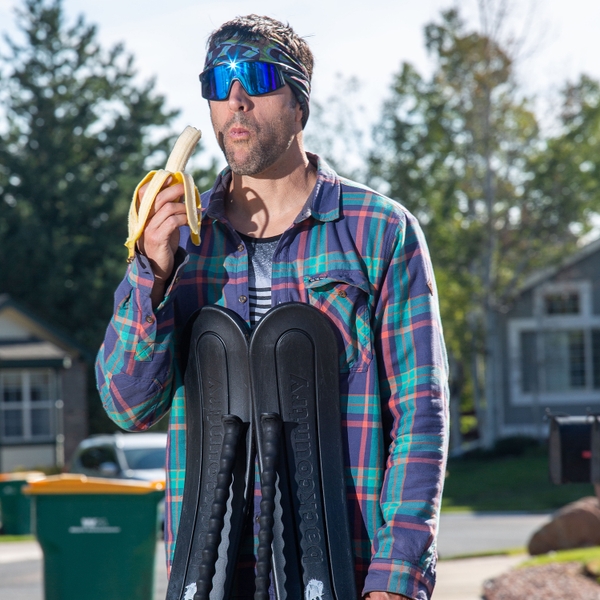The Weird Foothill Guy Believes His Style of Skiing Is Better than a Day at the Resort. We Tried It Out.
Alex Kaufman, a suburban dad in Denver, descends slopes with barely any snow, using discontinued plastic skis. This method, he says, is far more fun than a day at the resort, so we accompanied him on an outing.
New perk: Easily find new routes and hidden gems, upcoming running events, and more near you. Your weekly Local Running Newsletter has everything you need to lace up! .
Whump! My face plant is sudden, a cartwheel of flying ski poles and curse words into powder. The sting of snow on bare skin jolts my eyes open, and I hear a chorus of woo! erupt lower on the slope.
“Yeah, Fred!” a voice bellows. “You were a little too far forward—remember to keep your weight back.”
I brush myself off and schuss down the powdery hillside to my two companions, wondering how my 38 years of skiing experience seemingly evaporated in an instant. But I have little time to nurse my bruised pride—my new friends are already making their way up the slope for another run. I struggle to keep pace as we trudge toward the summit of this wooded hillside in Genesee, an upscale neighborhood in Denver’s western suburbs. I look to an adjacent hilltop and see the familiar elliptical sides of the Sculptured House, the mansion built by architect Charles Deaton featured in the 1973 film ����������.��
The guy in front of me, Wade Wilson, is a wiry real estate agent from nearby Golden. In front of him is Alex Kaufman, also from Golden, who dishes out rapid-fire advice as we climb. Keep your weight over your arches, not the balls of your feet. You don’t edge the turns like on a normal ski, you just kind of waggle your knees. Don’t worry if you hit a rock, just let the skis do their job.
“You’ll get the hang of it, I promise,” Kaufman says. “Everyone sucks their first time.” Kaufman, 45, is a father of two, a youth soccer coach, and the chief operating officer of Kaufman Asset Management, a company that invests in affordable housing. But I’m here because Kaufman is also a budding social media celebrity in the U.S. skiing world, where fans know him as the Weird Foothill Guy.
The Weird Foothill Guy only boasts about 11,000 followers across his channels, but his audience includes ski-industry heads of state, outdoor journalists, and even a few official resort accounts. I started following him in 2023 and quickly became obsessed with his online musings. Like many snow-sports aficionados, he regularly posts about the shoddy state of American skiing: massive lift lines, $48 cheeseburgers, and miles-long traffic jams on Interstate 70, the main artery connecting Denver with the resorts. “Economic vitality!” he once tweeted next to a video of a January traffic jam that stranded some motorists for ten hours on the freeway.
But most Weird Foothill Guy content promotes Kaufman’s highly unorthodox style of backcountry skiing—one that seems to defy logic. He skis up and down slopes that are just a few miles from downtown Denver—hillsides with so little snowpack (and so many rocks and stumps) that your daredevil nephew wouldn’t sled down them, let alone tackle them on skis. Yet Kaufman navigates this terrain three or four days a week during the winter, often on his lunch break or before work. He floods social media with photos from these micro-adventures, alongside captions that express his radical view on the sport. Basically: Resort skiing sucks and I’ve discovered an amazing alternative.
Kaufman’s brand of skiing—which he calls Simple Skiing—relies on a bizarre plastic ski called the Marquette Backcountry, which looks like a cross between a child’s toy and a float pontoon. He did not invent these strange skis, but he has become their strongest evangelist. He keeps a small fleet of them in his garage, and lends them out to anyone who wants to try them, including me. Descending on them presents an ample learning curve, as I have just discovered. Ascending is similarly challenging. You don’t use climbing skins. The skis have fish-scale-like divots on the bottoms that grip the snow, similar to the ones on some cross-country skis.
Wilson and Kaufman speed ahead. Kaufman is wearing a pair of basketball shorts over tights and a flannel shirt. An orange handkerchief flutters from his back pocket. “I have the bandana in case hunters spot me,” he says. “I never wear ski pants—you get too hot.”
I soon learn this lesson, as my core temperature spikes under my preferred backcountry outfit. Snowmelt from my crash drips down my back and soaks my long underwear, and I wonder: Is this really better than a day at the resort?
I find my answer at the summit. Wilson and Kaufman have waited for me, and as I reach the top, I look down from our perch. Below us is I-70, packed with cars; a serpentine line of red brake lights stretching to the horizon. The traffic is barely inching along, and the nearest resort is still 45 miles up the road. I shift my gaze to the snowy slope below my skis. We’re completely alone, shredding untracked powder just 25 minutes from downtown Denver.
“We’ll be home eating breakfast before they’re in the parking lot,” Kaufman says. “C’mon, let’s hit another run.”



